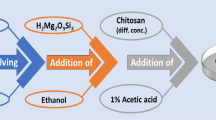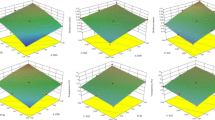Abstract
The gelatin-based nanocomposite films (GNCFs) containing 0, 1, 3, and 5% zinc oxide nanoparticles (N-ZnO) and/or 0, 3, 5, and 10% chitin nanofibers (N-chitin) were prepared, and their water vapor permeability (WVP), chemical structure and microstructure, and their mechanical, thermal, and antifungal properties were investigated. Results showed that incorporation of N-ZnO improved WVP, mechanical, thermal, and antifungal properties of the gelatin-based films. Moreover, physicochemical and antifungal properties of the nanocomposite films improved by increasing N-ZnO concentration. However, applying N-chitin in gelatin films could not enhance barrier properties of the films against water vapor, probably due to the hydrophilic nature of N-chitin. On the other hand, tensile strength of the GNCFs containing N-chitin increased by an increase in nanoparticle concentration, up to 5%, Incorporation of N-chitin in the gelatin film raised both thermal stability and antifungal activity. Simultaneous incorporation of chitin and ZnO nanoparticles in the GNCFs had the interactive effect on improving the physicochemical and antimicrobial properties of GNCFs. For instance, thermograms of differential scanning calorimetry (DSC) showed that the GNCF containing both nanoparticles increased melting point and ∆H m in comparison with net gelatin film. Furthermore, thermograms of thermogravimetric analysis (TGA) indicated that applying both of nanoparticles in gelatin films led to higher thermal stability of polymer against decomposition at higher temperatures, compared to the gelatin film containing each of them.





Similar content being viewed by others
References
Arfat, Y., Benjakul, S., Prodpran, T., Sumpavapol, P., & Songtipya, P. (2014). Properties and antimicrobial activity of fish protein isolate/fish skin gelatin film containing basil leaf essential oil and zinc oxide nanoparticles. Food Hydrocolloids, 41, 265–273.
Bao, S., Xu, S., & Wang, Z. (2009). Antioxidant activity and properties of gelatin films incorporated with tea polyphenol-loaded chitosan nanoparticles. Journal of Science of Food and Agriculture, 89, 2692–2700.
Bertan, L. C., Tanada-Palmu, P. S., Siani, A. C., & Grosso, C. R. F. (2005). Effect of fatty acids and ‘Brazilian elemi’ on composite films based on gelatin. Food Hydrocolloids, 19, 73–82.
Carvalho, R. A., & Grosso, C. R. F. (2004). Characterization of gelatin based films modified with transglutaminase, glyoxal and formaldehyde. Food Hydrocolloids, 18, 717–726.
Cerqueira, M. A., Souza, B. W. S., Teixeira, J. A., & Vicente, A. A. (2011). Effect of glycerol and corn oil on physicochemical properties of polysaccharide films—a comparative study. Food Hydrocolloids, 27(1), 175–184.
Chambi, H., & Grosso, C. (2006). Edible films produced with gelatin and casein crosslinked with transglutaminase. Food Research International, 39, 458–466.
Chang, P. R., Jian, R., Yu, J., & Ma, X. (2010). Starch-based composites reinforced with novel chitin nanoparticles. Carbohydrate Polymers, 80, 420–425.
Chen, Z., Mo, X. M., He, C. L., & Wang, H. S. (2008). Intermolecular interactions in electrospun collagen-chitosan complex nanofibers. Carbohydrate Polymers, 72, 410–418.
Espitia, P. J., Soares, N. F., Coimbra, J. S., Andrade, N. J., Cruz, R. S., & Medeiros, E. A. (2012). Zinc oxide nanoparticles: synthesis, antimicrobial activity and food packaging applications. Food and Bioprocess Technology, 5, 1447–1464.
Ghanbarzadeh, B., Almasi, H., & Entezam, A. A. (2010). Physical properties of edible modified starch/carboxymethyl cellulose films. Innovative Food Science and Emerging Technologies, 11, 697–702.
Gomez-Guillen, M. C., Ihl, M., Bifani, V., Silva, A., & Montero, P. (2007). Edible films made from tuna-fish gelatin with antioxidant extracts of two different murta ecotypes leaves (Ugni molinae Turcz). Food Hydrocolloids, 21, 1133–1143.
Harish Prashanth, K., & Tharanathan, R. N. (2007). Chitin/chitosan: modifications and their unlimited application potential—an overview. Trends in Food Science and Technology, 18, 117–131.
He, L., Liu, Y., Mustapha, A., & Lin, M. (2011). Antifungal activity of zinc oxide nanoparticles against Botrytis cinerea and Penicillium expansum. Microbiological Research, 166(3), 207–215.
He, Q., Zhang, Y., Cai, X., & Wang, S. (2016). Fabrication of gelatin-TiO2 nanocomposite film and its structural, antibacterial and physical properties. International Journal of Biological Macromolecules, 84, 153–160.
Hosseini, S. F., Rezaei, M., Zandi, M., & Farahmandghavi, F. (2015). Fabrication of bio-nanocomposite films based on fish gelatin reinforced with chitosan nanoparticles. Food Hydrocolloids, 44, 172–182.
Kanmani, P., & Rhim, J. (2013). Physical, mechanical and antimicrobial properties of gelatin based active nanocomposite films containing AgNPs and nanoclay. Food Hydrocolloids, 35, 644–652.
Kanmani, P., & Rhim, J. (2014a). Physicochemical properties of gelatin/silver nanoparticle antimicrobial composite films. Food Chemistry, 148, 162–169.
Kanmani, P., & Rhim, J. (2014b). Properties and characterization of bionanocomposite films prepared with various biopolymers and ZnO nanoparticles. Carbohydrate Polymers, 106, 190–199.
Kim, D., Jeon, K., Lee, Y., Seo, J., Seo, K., Han, H., & Khan, S. (2012). Preparation and characterization of UV-cured polyurethane acrylate/ZnO nanocomposite films based on surface modified ZnO. Progress in Organic Coating, 74, 435–442.
Li, X., Xing, Y., Jiang, Y., Ding, Y., & Li, W. (2009). Antimicrobial activities of ZnO powder coated PVC film to inactivate food pathogens. International Journal of Food Science and Technology, 44, 2161–2168.
Lian, Z., Zhang, Y., & Zhao, Y. (2016). Nano-TiO2 particles and high hydrostatic pressure treatment for improving functionality of polyvinyl alcohol and chitosan composite films and nano-TiO2migration from film matrix in food stimulants. Innovative Food Science and Emerging Technologies, 33, 145–153.
Liu, F., Antoniou, J., Li, Y., Ma, J., & Zhong, F. (2015). Effect of sodium acetate and drying temperature on physicochemical and thermomechanical properties of gelatin films. Food Hydrocolloids, 45, 140–149.
Llorens, A., Lloret, E., Picouet, P. A., Trbojevich, R., & Fernandez, A. (2012). Metallic-based micro and nanocomposites in food contact materials and active food packaging. Trends in Food Science and Technology, 24, 19–29.
Lotti, C., Isaac, C. S., Branciforti, M. C., Alves, R. M. V., Liberman, S., & Bretas, R. E. S. (2008). Rheological, mechanical and transport properties of blown films of high density polyethylene nanocomposites. European Polymer Journal, 44(5), 1346–1357.
Lu, Y., Weng, L., & Zhang, L. (2004). Morphology and properties of soy protein isolate thermoplastics reinforced with chitin whiskers. Biomacromolecules, 5, 1046–1051.
Nafchi, A., Moradpour, M., Saeidi, M., & Alias, A. (2014). Effects of nanorod-rich ZnO on rheological, sorption isotherm, and physicochemical properties of bovine gelatin films. LWT-Food Science and Technology, 58, 142–149.
Nasreen, Z., Khan, M. A., & Mustafa, A. I. (2016). Improved biodegradable radiation cured polymeric film prepared from chitosan-gelatin blend. Journal of Applied Chemistry, 2016, 1–11.
Nur Hanani, Z.A., McNamara, J., Roos, Y.H., Kerry, J.P. (2013). Effect of plasticizer content on the functional properties of extruded gelatin-based composite films. Food Hydrocolloids, 31, 264–269.
Ramos, O. L., Reinas, I., Silva, S. I., Fernandes, J. C., Cerqueira, M. A., & Pereira, R. N. (2013). Effect of whey protein purity and glycerol content upon physical properties of edible films manufactured therefrom. Food Hydrocolloids, 30, 110–122.
Rhim, J. W., Lee, S. B., & Hong, S. I. (2011). Preparation and characterization of agar/clay nanocomposite films: the effect of clay type. Journal of Food Science, 76, 40–48.
Rhim, J. W., Park, H. M., & Ha, C. S. (2013b). Bio-nanocomposites for food packaging applications. Progress in Polymer Science, 38, 1629–1652.
Rhim, J. W., Wang, L. F., & Hong, S. I. (2013a). Preparation and characterization of agar/silver nanoparticles composite films with antimicrobial activity. Food Hydrocolloids, 33, 327–335.
Rouhi, J., Mahmud, S., Naderi, N., Ooi, C. H. R., & Mahmood, M. R. (2013). Physical properties of fish gelatin-based bio-nanocomposite films incorporated with ZnO nanorods. Nanoscale Research Letters, 8, 364–368.
Rubentheren, V., Ward, T. A., Chee, C. Y., & Tang, C. K. (2015). Processing and analysis of chitosan nanocomposites reinforced with chitin whiskers and tannic acid as a crosslinker. Carbohydrate Polymers, 115, 379–387.
Sahraee, S., Milani, J. M., Ghanbarzadeh, B., & Hamishekar, H. (2017). Effect of corn oil on physical, thermal, and antifungal properties of gelatin-based nanocomposite films containing nano chitin. LWT-Food Science and Technology, 76, 33–39.
Salaberria, A. M., Fernandes, S. C., Diaz, R. H., & Labidi, J. (2014). Processing of chitin nanofibers by dynamic high pressure homogenization: characterization and antifungal activity against A. niger. Carbohydrate Polymers, 116, 286–291.
Salaberria, A. M., Fernandes, S. C., Diaz, R. H., & Labidi, J. (2015a). Processing of α-chitin nanofibers by dynamic high pressure homogenization: characterization and antifungal activity against A. niger. Carbohydrate Polymers, 116, 286–291.
Salaberria, A. M., Labidi, J., & Fernandes, S. (2015b). Different routes to turn chitin into stunning nano-objects. European Polymer Journal, 68, 503–515.
Sanuja, S., Agalya, A., & Umapathy, M. J. (2015). Synthesis and characterization of zinc oxide-neem oil-chitosan bionanocomposite for food packaging application. International Journal of Biological Macromolecules, 74, 76–84.
Shankar, S., Reddy, J., Rhima, J., & Kim, H. (2015a). Preparation, characterization, and antimicrobial activity of chitin nanofibrils reinforced carrageenan nanocomposite films. Carbohydrate Polymers, 117, 468–475.
Shankar, S., Teng, X., Li, G., & Rhim, J. (2015b). Preparation, characterization, and antimicrobial activity of gelatin/ZnO nanocomposite films. Food Hydrocolloids, 45, 264–271.
Shiku, Y., Hamaguchi, P. Y., Benjakul, S., Visessanguan, W., & Tanaka, M. (2004). Effect of surimi quality on properties of edible films based on Alaska pollack. Food Chemistry, 86, 493–499.
Sun, Q., Xi, T., Li, Y., & Xiong, L. (2014). Characterization of corn starch films reinforced with CaCO3 nanoparticles. PloS One, 9(9), 1–6.
Tang, H., Lu, L., Li, L., Zhou, W., Xie, Z., & Zhang, L. (2013). Highly antibacterial materials constructed from silver molybdate nanoparticles immobilized in chitin matrix. Chemical Engineering Journal, 234, 124–131.
Tankhiwale, R., & Bajpai, S. K. (2012). Preparation, characterization and antibacterial applications of ZnO-nanoparticles coated polyethylene films for food packaging. Colloids and Surfaces B: Biointerfaces, 90, 16–20.
Tongdeesoontorn, W., Mauer, L. J., Wongruong, S., Sriburi, P., & Rachtanapun, P. (2011). Effect of carboxymethyl cellulose concentration on physical properties of biodegradable cassava starch-based films. Chemistry Central Journal, 5(1), 1–6.
Tronci, G., Doyle, A., Russell, S. J., & Wood, D. J. (2013). Triple-helical collagen hydrogels via covalent aromatic functionalisation with 1,3-phenylenediacetic acid. Journal of Materials Chemistry B, 1(40), 5478–5488.
Author information
Authors and Affiliations
Corresponding author
Rights and permissions
About this article
Cite this article
Sahraee, S., Ghanbarzadeh, B., Milani, J.M. et al. Development of Gelatin Bionanocomposite Films Containing Chitin and ZnO Nanoparticles. Food Bioprocess Technol 10, 1441–1453 (2017). https://doi.org/10.1007/s11947-017-1907-2
Received:
Accepted:
Published:
Issue Date:
DOI: https://doi.org/10.1007/s11947-017-1907-2




